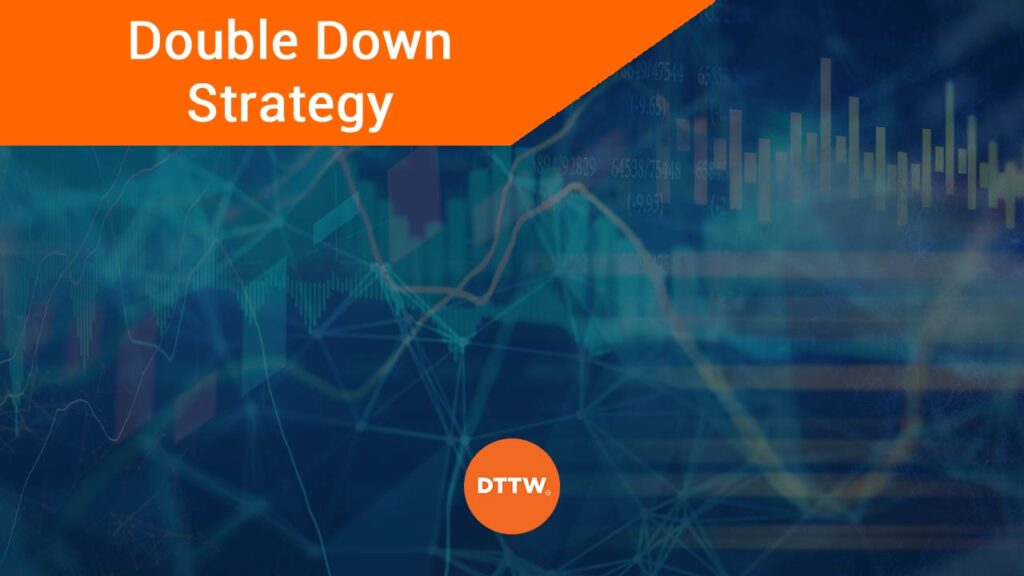A double down trading strategy is one that involves pouring your money into a losing trade hoping that you will make money when the reversal happens.
The strategy is similar to the Martingale strategy and the dollar-cost averaging approaches. In this article, we will look at how to use the double down strategy and the risks involved.
Table of Contents
What is the double down trading strategy?
As a trader with a loss-making trade, you have several approaches. First, you can exit the trade at a loss and look for opportunities elsewhere. Second, you can hold the loss-making trade for a while and hope that its price will reverse. Third, you could decide to double-down on your trade by buying or shorting more. By so doing, your hope is that the price will reverse and your losses reduced.
The latter approach refers to the double-down strategy that is the main topic in this article. The strategy involves adding more into a losing trade and hoping that the reversal will help you recover your losses. In other words, you are attempting to time the market.
» Related: How to trade reversal patterns
Example of doubling down
The best way of explaining this strategy is to use an example. The chart below shows that a trader bought shares in MarketAccess Holdings at around $561. At the time, the trader hoped that the stock will keep rising. However, the market turned around and the stock declined by 23% to about $433,
Therefore, since the trader has made a major loss in this single trade, they could attempt to use the double-down strategy. In this case, they could have bought the stock at around $433. In this case, if the shares rebound as they did, the trader made a profit. As a result, their original losses will be erased.
This trading strategy is mostly used by both scalpers and long-term investors. It is a relatively risky trading strategy that is only recommended for advanced traders.
Related » DT vs Long Term: Who’s riskier?
Risks involved
Its main risk is that it attempts to move against the overall trend. In the example above, there was a also a possibility that the stock would not turn around. Instead, it would have continued with the bearish trend and lead to substantial losses to the trader.
There is the risk that the trade will not have another reversal. Otherwise, there is the risk that the chart will keep falling for an extended period of time. Another one, by doubling down, you may miss other opportunities that emerge in other places.
Doubling down vs Martingale strategy
As you have noted, doubling down is closely associated with the Martingale trading system. For starters, the Martingale is a trading procedure that involves doubling the size of a losing trade.
For example, assume that the trader had bought 100 shares of MarketAxess Holdings above. Now, with the trade going in the opposite direction, the Martingale the trader will typically keep increasing the size of the next trades. In this case, the trader will buy 150, 200, and even 300 shares.
The goal is that if there is a small rebound, the winning trade will lead to substantial profits that will erase the initial losses.
In most cases, the Martingale strategy is usually relatively riskier than the one on doubling down. It is riskier because it leads to higher losses if the trade keeps going against you. For example, if 100 shares led to a big loss, then 200 and 400 shares will lead to a bigger loss if things don’t go your way.
The Martingale system is mostly used in the gambling industry.
»Related: Why Do Poker Players Become Successful Day Traders?
Doubling down vs dollar-cost averaging
Meanwhile, the concept of doubling down has a relatively close relationship with the one on dollar-cost averaging. Dollar-cost averaging also involves slicing your funds and allocating the funds at different price levels.
For example, if you believe that a stock will keep rising and you have $10,000, you could divide these funds into 4. In this case, you will have four separate $2,500. If the stock is trading at $10, you could spend the initial $2,500 to buy 250 shares. If it drops to $8, you spend $2,500 to buy 312 shares.
Next, if it drops to $7, you spend $2,500 and buy 357 shares. And finally, if it drops to $6, you buy 416 shares. If the stock then starts a rebound and moves to $20, the one you bought at $6 will bring more returns than the bunch you bought at $10.
Risks of Dollar Averaging
Still, there are two main risks for the dollar-cost averaging strategy. First, if the price fails to reverse, your trades will keep making a loss. Second, there is the risk that the stock will bounce back before you allocate all your funds. In this case, you will have lost the opportunity of buying it at $10.
Summary
Doubling down is a risky strategy, one that we don’t recommend. Instead, we recommend that you always position your trades well to avoid making a big loss. As such, when you make a loss, you will be comfortable with it.
External useful Resources
- Blackjack double down: what does it mean and when should I do it? – The Telegraph





